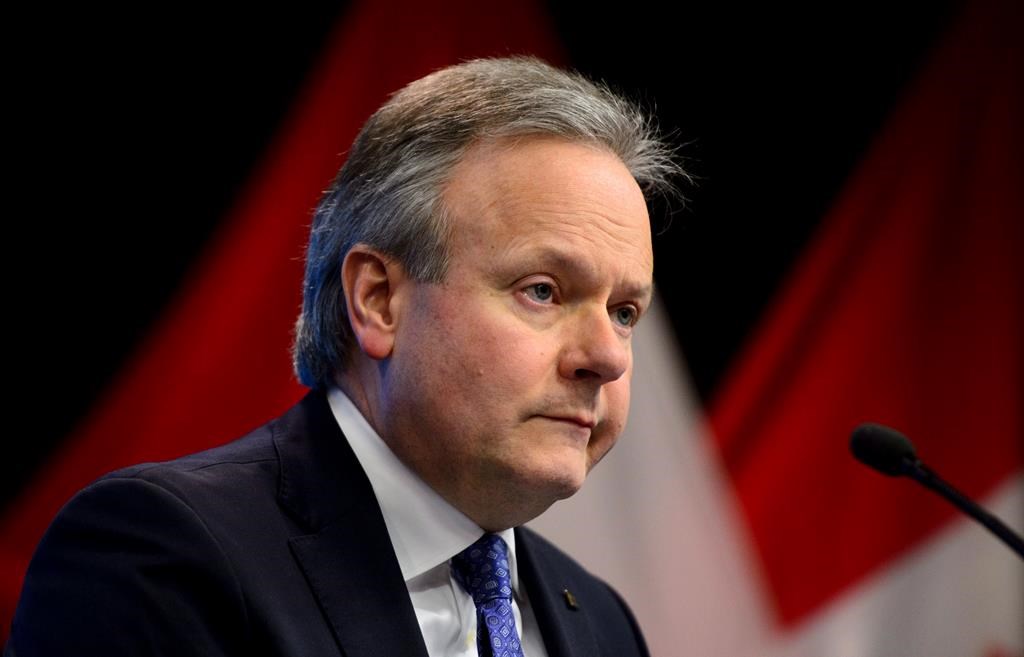The head of the Bank of Canada says his trend-setting interest rate is low enough, at its below-inflation level of 1.75 per cent, that it’s delivering stimulative effects to the economy. But even in the stronger economy, governor Stephen Poloz said on Thursday that the benchmark rate’s upward journey to its likely destination range of between 2.5 and 3.5 per cent is “highly uncertain.”

READ MORE: Bank of Canada keeps key rate at 1.75%, downgrades economic forecast
The bank’s destination range — or neutral range — is an estimate of the preferred level for the interest rate when the economy is operating at full capacity and inflation is within its target zone of one to three per cent.
In prepared remarks of a speech in Montreal, Poloz said the central bank will scrutinize incoming data in order to study how several important uncertainties unfold. They include, he added, the evolution of the impact of higher interest rates on indebted Canadians, how housing markets adjust to higher borrowing costs and stricter mortgage guidelines, whether business investment picks up its pace and the “highly uncertain” global trade environment.
“Given these uncertainties, we have kept interest rates unchanged at 1.75 per cent since last October,” Poloz said in his speech to the Chamber of Commerce of Metropolitan Montreal. “We will remain decidedly data-dependent as the domestic and international situations evolve.”
WATCH: Interest rates expected to move higher ‘over time,’ Poloz says

The improved economy has encouraged the bank to raise its key interest rate five times since mid-2017 to keep inflation from creeping up too high — but the central bank hasn’t introduced an increase since last October.
READ MORE: Southern Albertans feeling the pinch after Bank of Canada interest rate hike
“With that rate still lower than inflation, it is clear that monetary policy continues to deliver stimulus to the economy today,” Poloz said.
Statistics Canada’s December inflation reading was two per cent. Poloz has said the central bank will likely continue hiking rates once the economy builds new momentum following a soft patch largely caused by unexpectedly weak oil prices in late-2018.
WATCH: Oil ‘crisis’ top economic issue facing Canada, University of Saskatchewan professor says

The bank’s next interest-rate announcement is March 6 — and many market watchers expect Poloz to leave the benchmark untouched until late this year.
The governor’s speech Thursday walked the audience through the effectiveness and the limitations of the bank’s main policy tool: the key interest rate target. Poloz shared an example on what would have likely happened if the bank hadn’t introduced five quarter-point increases to bring the rate up to 1.75 per cent.
“If we had kept our interest rate at 0.5 per cent from mid-2015 until now, our models tell us that we would have seen stronger economic growth — no surprise there,” Poloz said. “By now, the level of (the growth domestic product) would be about two per cent higher than it is today.”
READ MORE: Oil-price rout doubles Canada’s trade deficit to $2.1B in November
However, he added that while such an increase may sound good, it would have pushed inflation to the top of the bank’s inflation range, and likely even higher. The bank would have then been compelled to raise rates “forcefully” to guide inflation back to its target over the next year or two, Poloz said.
With lower rates over a longer period, he added the average Canadian would have likely amassed about $2,000 more in additional debt.
- As Loblaw boycott begins, what to know about all the company’s brands
- $34B Trans Mountain pipeline expansion project opens after years of construction
- Toxic metals in vapes may pose major health risks for youth, study finds
- Nearly 60% of retirees are supporting adult children financially, survey finds



Comments